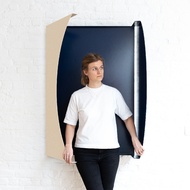
Lou van 't Riet
Sculptural, minimalist landscapes
With her work, Lou Van 't Riet (°1990, lives and works in Brussels) breaks through the detached aura that sometimes surrounds a work of art. She thus encourages viewers to touch the triptychs, interacting with the dynamic panels. 'When I worked at the New York Chamber Gallery after my studies, I noticed that most visitors only pay attention to a creation for a few seconds. I found that particularly unfortunate for both them and the designers. That's how I came up with the idea of involving the public more actively in my work,' Lou Van 't Riet explains. 'My triptychs are an invitation to touch and dialogue.
Because the different panels can move, new shapes and colour combinations arise each time, and the work takes on a sculptural, three-dimensional character.' Thus, a creation evolves from a closed rectangular shape to a more organic triptych, and along with the shape, the dimension also changes significantly. As a result, the work looks different every time, and continues to surprise. For the colour combinations, the Brussels-based artist draws inspiration from her travels. For instance, she translated the palette of the North Sea - different shades of beige and blue - to Noon (2021) and the terracotta colours and cacti of the Argentine desert to Cafayate (2021). 'Most works contain three or even five colours. My memory forms an emotional basis. I translate these through a precise search into a balanced composition that re-evokes the magic of the moment experienced,' says Van 't Riet. 'Thanks to the use of powder coating, the works are particularly resistant, so you don't have to be afraid to touch them frequently.'
Spatial play
With her limited series, Lou Van 't Riet - who studied interior architecture at the Brussels College of Art & Design and product design at the School of Visual Arts in New York - walks the fine line between art and design. 'In terms of process and method, I work like a designer, while the result is closer to the art world. Although those boxes don't matter to me. The tactile, but also spatial experience that the triptychs bring about is what matters,' Van 't Riet states. 'In that sense, I like the work of Donald Judd who explored disciplinary boundaries with his metal objects, or of Frank Stella who came up with alternatives to the static square canvas. Tadao Ando's pared-down architecture and Richard Serra's sculptures, which encourage people to walk around or through them and thus interact with the work as well as with each other, also make my heart beat faster,' says Van 't Riet.
In terms of form, dimension and colour, the minimalist landscapes offer endless possibilities. 'Normally I always work in limited series of six. Although sometimes I also make unique works on request. When doing so, I am inspired, for instance, by the interior or the environment where the work will be placed,' says Van 't Riet.